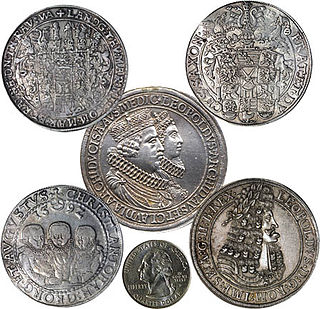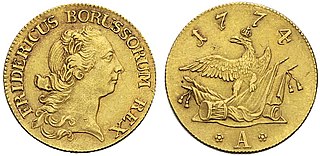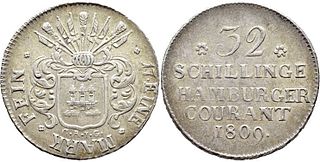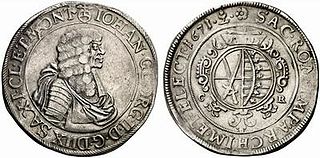
Guilder is the English translation of the Dutch and German gulden, originally shortened from Middle High German guldin pfenninc "gold penny". This was the term that became current in the southern and western parts of the Holy Roman Empire for the Fiorino d'oro. Hence, the name has often been interchangeable with florin.

A thaler or taler is one of the large silver coins minted in the states and territories of the Holy Roman Empire and the Habsburg monarchy during the Early Modern period. A thaler size silver coin has a diameter of about 40 mm and a weight of about 25 to 30 grams. The word is shortened from Joachimsthaler, the original thaler coin minted in Joachimsthal, Bohemia, from 1520.

Groschen is the name for various coins, especially a silver coin used in parts of Europe such as France, some of the Italian states, England, various states of the Holy Roman Empire, among others. The word is borrowed from the late Latin description of a tornose, a grossus denarius Turnosus, in English the "thick denarius of Tours". Groschen was frequently abbreviated in old documents to gl, whereby the second letter was not an l, but an abbreviation symbol; later it was written as Gr or g.

The Kreuzer, in English also spelled kreutzer, was a coin and unit of currency in the southern German states prior to the introduction of the German gold mark in 1871–1873, and in Austria and Switzerland. After 1760 it was made of copper. In south Germany the kreuzer was typically worth 4 pfennigs and there were 60 kreuzers to a gulden. Kreuzer was abbreviated as Kr, kr, K or Xr.

The Vereinsthaler was a standard silver coin used in most German states and the Austrian Empire in the years before German unification.

The Reichsthaler, or more specifically the Reichsthaler specie, was a standard thaler silver coin introduced by the Holy Roman Empire in 1566 for use in all German states, minted in various versions for the next 300 years, and containing 25–26 grams fine silver.

The Austro-Hungarian gulden was the currency of the lands of the House of Habsburg between 1754 and 1892, when it was replaced by the Austro-Hungarian krone as part of the introduction of the gold standard. In Austria, the gulden was initially divided into 60 kreuzers. The currency was decimalized in 1857, using the same names for the unit and subunit.
The South German Gulden was the currency of the states of Southern Germany between 1754 and 1873. These states included Bavaria, Baden, Württemberg, Frankfurt and Hohenzollern. It was divided into 60 kreuzer, with each kreuzer worth 4 pfennig or 8 heller.

The Thaler was the currency of the Free Hanseatic City of Bremen until 1873, when Germany adopted the gold mark (ℳ). It was divided into 72 Grote, each of 5 Schwaren. While initially identical to the North German thaler before the 1750s, it was the only currency to maintain the gold standard of 5 thalers to a Friedrich d'or pistole from the 1750s until 1873, long after all other states adopted the Conventionsthaler.

The Hamburg Mark refers to two distinct currencies issued in the city of Hamburg until 1875:

The Kronenthaler was a silver coin first issued in 1755 in the Austrian Netherlands and which became a popular trade coin in early 19th century Europe. Most examples show the bust of the Austrian ruler on the obverse and three or four crowns on the reverse, hence the name which means "crown thaler" (also Brabanter and crocione.
The Prussian Thaler was the currency of Prussia until 1857. In 1750, Johann Philipp Graumann implemented the Graumannscher Fuß with 14 thalers issued to a Cologne Mark of fine silver, or 16.704 g per thaler.
The Thaler was a coin issued by Baden of varying equivalents to its currency, the South German gulden, each of 60 kreuzer. Beginning in 1690, the Reichsthaler specie coin of 25.984 g fine silver was issued for 2 gulden. After 1754, the Conventionsthaler of 23.3856 g fine silver was issued for 2.4 gulden. Starting in the 19th, century the Kronenthaler of 25.71 g fine silver was issued for 2.7 gulden ; the French silver écu also started being accepted for 2.8 gulden. After 1837, the doppelthaler, which was worth two Prussian thalers, was issued for 31⁄2 gulden. From 1857 to 1871, the Vereinsthaler was issued for 13⁄4 gulden.
The North German thaler was a currency used by several states of Northern Germany from 1690 to 1873, first under the Holy Roman Empire, then by the German Confederation. Originally equal to the Reichsthaler specie or silver coin from 1566 until the Kipper und Wipper crisis of 1618, a thaler currency unit worth less than the Reichsthaler specie was first defined in 1667 and became widely used after adoption of the Leipzig currency standard of 1690.

The history of Saxon coinage or Meissen-Saxon coinage comprises three major periods: the high medieval regional pfennig period, the late medieval pfennig period and the thaler period, which ended with the introduction of the mark in 1871/72. Rich silver deposits, which were discovered near Freiberg after the middle of the 12th century, helped Saxony to a leading position in German coinage.

The Wechselthaler, also spelt Wechseltaler or Wechsel-Thaler, was minted in 1670 and 1671 in the Electorate of Saxony under Elector John George II (1656–1680) to the Wechselthaler or Burgundian thaler standard (861/1000 fineness). As the name suggests, the Wechselthaler and its subdivisions were intended as a currency to encourage Leipzig's trade with Hamburg and the Netherlands. The first coins from 1670 therefore bear the inscription WECHSELTHALER on the reverse. The Wechselthaler standard was only valid in Electoral Saxony in 1670 and 1671.
The Speciesthaler, also Speciestaler or Speziestaler, was a type of silver specie coin that was widespread from the 17th to the 19th century and was based on the 9-Thaler standard of the original Reichsthaler. In Scandinavian sources the term Speciesdaler is used and, in German sources, the abbreviation Species was also common.

From the Late Middle Ages the albus was a common currency in parts of the Holy Roman Empire, especially in the Rhineland. The name albus is Latin and means "white". Because of its higher silver content, this lighter coin differed in colour from the other inferior coins. This resulted in the names denarius albus, Weißpfennig or Rhenish groschen.

The schilling was the name of a coin in various historical European states and which gave its name to the English shilling. The schilling was a former currency in many of the German-speaking states of the Holy Roman Empire, including the Hanseatic city states of Hamburg and Lübeck, the March of Brandenburg, and the Duchies of Bavaria, Mecklenburg, and Württemberg. It was also used in Switzerland and in Austria, where silver schillings were introduced as recently as 1923.
Blaffert was the name of two different types of historical European coin. It was also called the Blafferd or, in Upper German, the Plappart, Plappert or Blaphart. It derives from the French blafard meaning "pale" or "bright".















